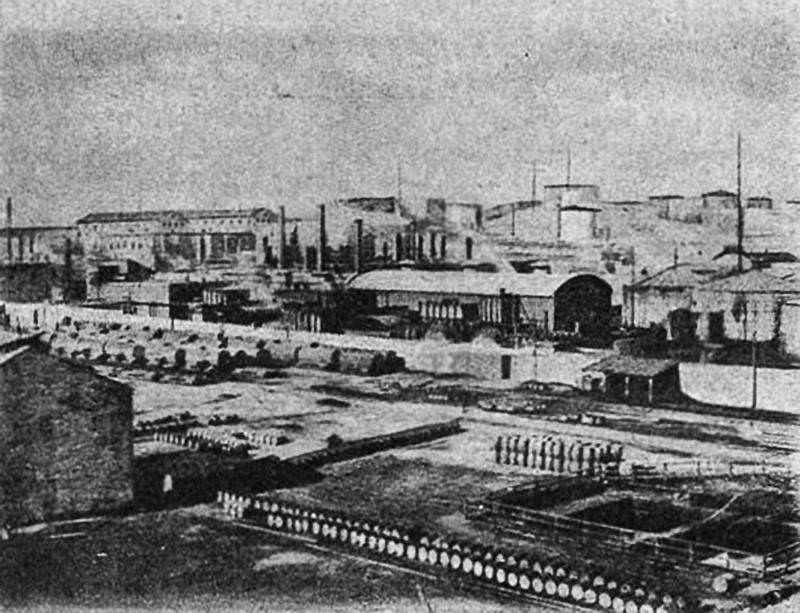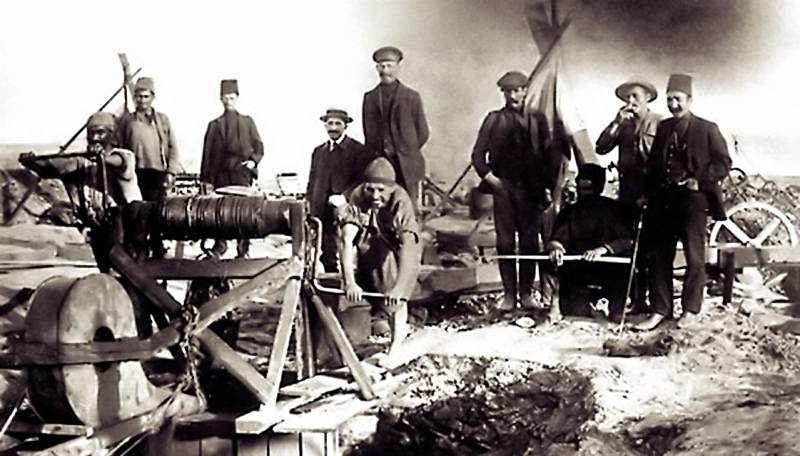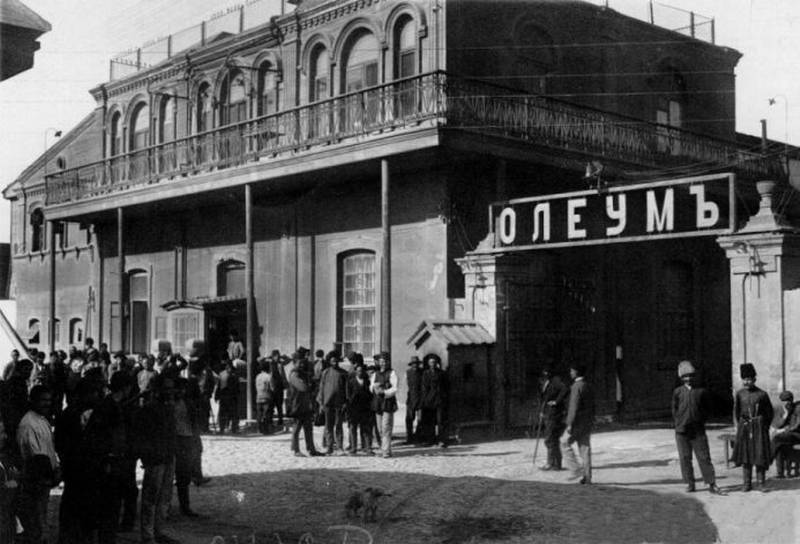Black city bombers. Revolutionary terror and expropriation of early twentieth century in Baku
In the period 1904-1908. Baku became the main center of the anarchist movement in the Caucasus. Although anarchist groups and organizations operated in Tiflis, Kutaisi, Armavir, Novorossiysk, Yekaterinodar and many other cities, it was in Baku that the most numerous and active anarchist movement was formed. Of course, this was due to the large share of the industrial proletariat in the population of the city. In Baku, people from all over the Russian Empire flocked to work in the oil fields, which turned the city into a kind of “melting pot”. Difficult working conditions at oil rigs and factories forced workers to think about exploitation and struggle for their rights and interests. At the same time, as in every major commercial and industrial city, there was a rather numerous and influential criminal world in Baku. As they would say now, Baku’s organized crime has become the second main source of the formation of revolutionary movements in the city, primarily the anarchist movement, with the ideology of which professional criminals have related the total rejection of the state and state power, the negative attitude towards the police and the court, the tendency to expropriation and extortion .

Active anarchist agitation in Baku began in 1904, and in 1905, a number of anarchist organizations emerged in the city. They acted both in Baku itself and in its working suburbs - Bibi-Eybat, Balakhani and Black City. Recall that in pre-revolutionary Baku there was a clear division - wealthy citizens lived in the city center, where oil fields were banned, and in the suburbs of Balakhani, Bibi-Eybat and Chernoi the oil was produced. Workers lived there. “Everything is black, the walls, the earth, the air, the sky. You feel the oil, inhale the fumes, the pungent smell suffocates you. You walk among the clouds of smoke that obscure the sky, ”a contemporary described the general view of Baku’s Black City. Naturally, workers, dissatisfied with working conditions, often went on strike. During the general strike in the summer of 1903, more than 90 oil towers were set on fire in Baku, in December 1904 - more than 200 towers, and in August 1905 in Bibi-Eybat from 600 towers burned 480.
The Anarchy group appeared in Baku, the Struggle in Bibi Heybat, the Bunt in Balakhani, and the Internationale in the Black City. The Anarchy group of anarchist communists, which operated in Baku itself, was created by the workers of one of the local enterprises, who earlier sympathized with the Social Democrats, but rejected the parliamentary struggle and eventually switched to anarchist positions. The ideologue of the Anarchy group was Sarkis Kalashyants, a former member of the Gnchak Party, who published a pamphlet entitled “To the Fight and Anarchy” under the pseudonym “Sevuni”.
1 July 1906. As a result of the split, another anarchist organization was created in the Anarchy group - the Baku group of anarchists-communists Red Hundred. Its activists claimed that they had left the ranks of “Anarchy” because of the bureaucracy and indecision of the group members. The “Red Hundreds” were striving for more radical and successful, in the opinion of the “Red Hundreds,” methods of warfare. The “Red Hundred” was headed by V. Zeints and A. Stern. Also in Baku appeared smaller groups “Anarchists - bombers”, “Anarchists - individualists”, “Red flag”, “Bread and will”, “Terror”, “Earth and will”, “Black raven”, etc. The ethnic composition of the Baku anarchists of the time was variegated, as was the population of the city. Russians prevailed, but there were also numerous Armenians, Jews, Georgians in the groups (in the “Red Hundred” there were 8 Georgian revolutionaries). The group of anarchists "Azad" was Azerbaijani in composition. Armenians, as a rule, came to the anarchist movement from the nationalist and socialist organizations “Gnchak” and “Dashnaktsutyun”, disillusioned with their ideology and methods of struggle. As for the Jews, they came from social democratic and social zionist organizations.
Among the Azerbaijanis who joined the anarchist movement, there were many yesterday's robbers - “kochi”, who were politicized and decided to give an ideological focus to their activities. It was the former Kochi that formed the backbone of the Azerbaijani anarchist group Azad, which appeared in 1906 and consisted of 15 people. At the head of the group “Azad” were the brothers Aga-Kerim and Aga-Sanguli. According to the “old memory”, the “Azad” group was in confrontation with a group of criminals under the leadership of Teymur Ashurbekov. But when, at the end of 1907, the police arrested both Ashurbekov and Azad leader Aga-Kerim, the Azad anarchist group ceased to exist. A number of former Kochi, who were part of it, went to other groups. The average age of anarchists was somewhat older than in the western regions of the Russian Empire — about 28-30 years. This was due to the fact that in Baku, the main part of the movement’s activists were local workers, not students.
Intensification of the anarchist movement in the city was promoted by regular bloody clashes between Azerbaijanis and Armenians. The tsarist government has allocated 16 millions of rubles for the organization of assistance to victims of the massacre of Baku people. But the allocated funds were in the hands of the joint-stock company of manganese-industrialists, who in fact appropriated state money, refusing to give aid to Baku workers. The strike began, which lasted two months, but businessmen still did not want to share money. In the end, the anarchists killed the factory director I. Dolukhanov, and also attempted to assassinate the factory director Urkarta, who also was a British vice-consul. In the working environment of Baku this anarchist action was supported, and the businessmen, fearing the following attempts, were forced to pay the workers.
But Dolukhanov was not just an industrialist, but also a sponsor of the Armenian Dashnaktsutyun party. Naturally, the Dashnaks could not leave unpunished the murder of such a prominent figure associated with their party. In response to the death of Dolukhanov, in September 1906, the Dashnaks killed the leader of the Anarchy group, Sarkis Kalashyants, as well as several anarchist workers. A bloody war broke out between the two organizations, in which 11 anarchists and 17 Dashnaks died. After the death of the Kalashyants, the Anarchy group was also headed by Armenians H. Zakharyants and A. Ter-Sarkisov and Russian F. Yatsenko. In the same September, 1906, while trying to escape from prison, the leaders of the Red Hundred group, V. Zeints and A. Stern, were killed. After their death, the Red Hundred group was headed by Russian workers M. Zayachenkov and P. Studnev. In addition to the Dashnaks, the Green Hundred, an armed detachment hired by Baku businessmen to defend against the expropriations and attacks of revolutionaries, became a serious opponent of the anarchists.

The high-profile events related to Baku anarchists include the battle in the Sevastopol restaurant 11 in September 1906. A large number of anarchists from different groups arrived at this institution. However, the police, having learned about the event, surrounded the restaurant, calling for reinforcements in the face of the soldiers of the infantry battalion. A firefight began, as a result of which the police managed to arrest 38 people and found in the neighboring house a whole warehouse of small weapons. A large-scale repression against the Baku anarchist movement began, leading to the arrest of 88 people. At the same time, many anarchists managed to escape from the city. Some of them subsequently settled in Batumi, where, under the leadership of David Rostomashvili (“Black Datiko”), the Batumi Workers Syndicate of Communist Anarchists “Internationale” was created, borrowing methods of struggle of Baku anarchists.
In 1906-1908 Baku anarchists have committed many attacks, assassinations and murders. Most often, the victims of the attacks were the police. Thus, Baku’s anarchists killed the assistant chief of police Жghenti, police guards Kudryashov and Zavgorodniy, detectives Levin, Rachkovsky and Debtors, bailiffs Richter and Prokopovich, the superintendent of the prison Prokopenko, the policeman Pestov. In addition, the victims of the attacks were Swedish citizens Eklund and Tuasson, who worked respectively as a manager and engineer at the Nobel plant. Responsibility for these attacks was claimed by the Red Hundred group. Abram Stern, the Shlimak brothers, the Shishkin brothers, the Polyakovs, the Old Believers, and the Ter-Galustovs were the perpetrators of the killings. As you can see, the composition of anarchists - militants, to match with Baku, was also international. In addition, militants of the Anarchy and Struggle groups in 1906 killed the managers of the Bibi-Heybat oil fields Urbanovich and Slavsky, a secret police officer of Tavmisian. In December 1907, a bomb was thrown at Lieutenant Colonel Chernyshev, the police chief of Baku himself, who survived only by a lucky chance.
A bold attack by the anarchists on the mail ship "Tsesarevich", which belonged to the society "Caucasus and Mercury", became widely known. The expropriation was attended by members of the communist anarchists “Red hundred” I. Mdinaradze, N. Beburashvili, S. Topuria, G. Gobirahashvili. The captured funds went to the organization of assistance to striking workers and the organizational needs of the anarchist movement. After all, in addition to the “eksov” and attacks, the Baku anarchists tried to engage in propaganda activities, issuing leaflets, proclamations and brochures. The anarchist press of the time praised the “feats of the fallen fighters”, propagandized expropriation and assassination as a mandatory component of the revolutionary struggle. A characteristic feature of the Baku anarchists, as well as the anarchists of Transcaucasia in general, was a greater tendency toward expropriation and close ties with the criminal environment, compared with Western or Central Russia, a local flavor was felt.
Ultimately, it was criminalization that discredited the anarchist movement in Baku. K 1907-1908 such political groups as the Baku Society of Terrorists and Anarchist Individualists, Black Raven, Terror and Red Flag, which were more criminal than revolutionary and specialized in robberies of shops and firms, took over the palm of political organizations. As in the criminal world, clashes periodically arose between rival anarchist groups, ending in armed clashes. Anarchists died in exchanges of fire and fights with each other, which also contributed to the reduction of their authority in the working environment of Baku. In addition, the Social Democrats were gaining strength in the labor movement, who created for themselves the image of more thorough and serious fighters for the work. The Social Democrats waged an active ideological struggle against the anarchists, constantly exposing the criminal bias in the activities of the Baku anarchist groups.
After the defeat of the first Russian revolution of 1905-1907, in Baku, as well as in the whole country, mass repressions against the revolutionary movement began. Naturally, the first thing the police of the city dealt with anarchist groups. Only in March of 1908 by the Baku police were 50 arrested members of the Red Hundred group, who were sentenced to exile in Siberia. In 1909, the anarchist arrests continued, and during a search of the apartment of certain D. Veselov and E. Rudenko, explosives, bombs, underground literature were found. In the same 1909, the Baku police succeeded in arresting almost all members of the Black Raven, Terror, and Red Banner groups, who became famous for their series of robberies and robberies. Thus, after large-scale police repression in 1908-1909. the anarchist movement in Baku was actually crushed. The anarchists didn’t recover from the consequences of such a serious blow to the Baku anarchists - in the “oil capital” of the Caucasus, the movement of powerless supporters came to nothing and did not show serious activity even during the Civil War, which became the period of the revival of anarchism.

Information